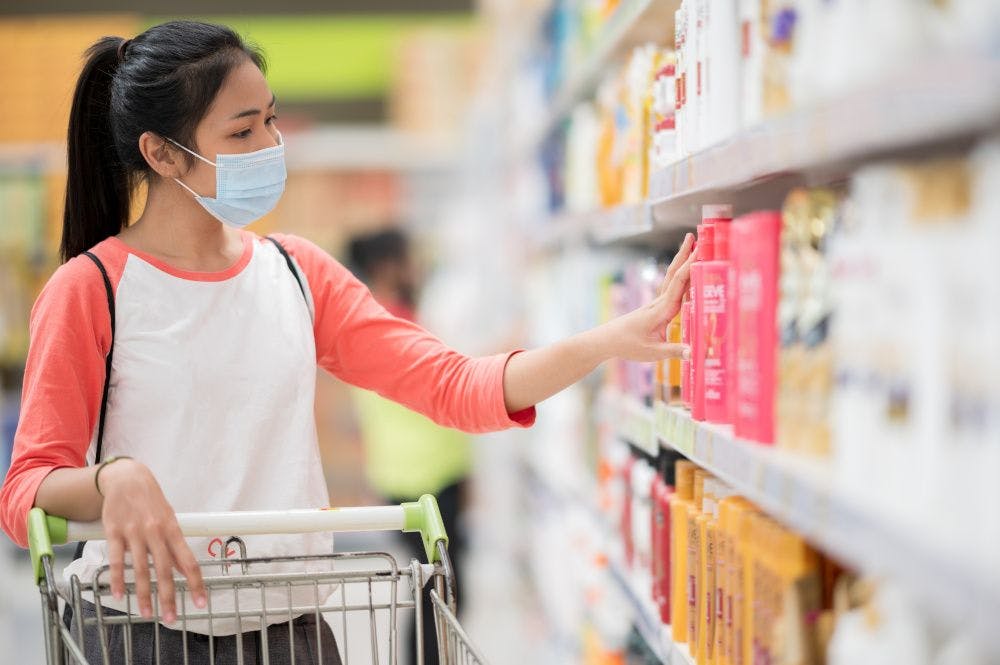How has COVID-19 impacted the natural and functional food industries?
How have natural and functional food shopping habits and priorities changed during the pandemic?
Photo © AdobeStock.com/mnirat

You’ve got to hand it to COVID-19 for bringing out our extremes. If we’re not chilling at home with Netflix, we’re at the track doing bleacher sprints; if we’re not building a bunker in the basement, we’re first in line at the sidewalk café reopening. And if we aren’t sending sales of sweet and salty comfort foods skyrocketing, we’re rediscovering the power of nutrition to fortify our bodies against the coronavirus to come.
That last of which spells opportunity for natural and functional food and beverage brands—right?
Well…As belts tighten amidst recession fears—and as retailing upheavals transform the natural-products space—there’s no lack of COVID-driven headwinds shredding the silver lining on the natural sector’s cloud. (And don’t forget the therapeutic appeal of those sweet and salty comfort foods.)
But no matter how this storm blows over, says Simon Gunzburg, research analyst, Euromonitor International (Chicago), “COVID-19 has put health at the forefront of consumers’ minds. So they’re paying even more attention to the foods they purchase.”
Strong Start
As Gunzburg continues, “The idea that diet was integral to overall health was already growing prior to COVID. But the pandemic has amplified that notion even further.”
Based on his reading of partial-year sales data for 2020 as well as conversations with industry players, he has no doubt that this keener focus on health and wellness means “consumers are even more interested in natural and functional foods than before.”
And they were pretty interested before. According to SPINS (Chicago) and IRI (Chicago) research, the natural-products industry represents 8.4% YTD of total store sales and continues to outpace non-natural and conventional products. In fact, data shows that the natural sector contributed more growth overall than did its non-natural counterpart in advance of COVID-19.1
Varied Responses
Yet while concerns about the pandemic’s effects are “near universal,” how individual shoppers respond to those concerns understandably varies, says Abby Cullinan, senior consultant, Hartman Retainer Services, Hartman Group (Bellevue, WA).
Interviews that the Hartman Group conducted with consumers as part of its April Functional Food & Beverage and Supplements 2020 report2 reveal a pulling back on functional food and beverage purchases among some shoppers who consider the products “less relevant right now,” Cullinan says. “Maybe they were buying convenience-oriented nutrition drinks to refuel from gym workouts, and now they have a different exercise routine and can make their own beverages at home.”
Nevertheless, the same research found “many instances of people consuming more functional and natural foods than before,” Cullinan continues, “as they rededicate themselves to healthy eating or supplementing for additional benefits.” To wit, 29% of American adults have upped their functional and natural consumption, per the report.
More than Insurance
To be sure, those consumers expect a lot from functional and natural foods in the bargain: improved immunity, relief from anxiety, all-around wellness and prevention. “And the list goes on,” Cullinan says.
Hartman Group data show an equal emphasis among consumers on what Cullinan calls “general ‘insurance’”—“covering your bases with prevention and nutrition”—as on the targeted benefits that have been much vaunted during the pandemic, including the aforementioned immunity and mood boosts, improved digestion, and better sleep, as well.
“And younger consumers have an even longer list of asks,” Cullinan adds. “More than half of Gen Z and Millennial shoppers are actively managing their cognitive health.”
On the Shelves
Translated in formulations, those asks have shone a spotlight on ingredients across the nutritional spectrum, including “standbys” like vitamin C as well as botanicals like elderberry and medicinal mushrooms, Cullinan says.
Mushrooms—with a rich history of immune-boosting use in Asian medicine—have attracted particular attention. According to IRI and SPINS data, the category saw an 876% sales increase over the previous year for the four weeks ending April 19, 2020.1
Meanwhile, antioxidant-packed oregano oil enjoyed its own hefty year-over-year sales jump of 276% during the same period. And—not surprisingly—sales of the sleep aid melatonin were up 52% vis-à-vis the previous year during the period; children’s melatonin even shot up 87% compared to a year ago for the four weeks ending March 22, 2020.1
Gunzburg points out that probiotic foods have performed well, too, in no small part thanks to their association with a healthy microbiome and, by extension, improved immunity. And while “growth here isn’t unique to 2020,” he says, “COVID has made immunity more of a top concern for consumers.”
Then there’s the continued success of plant-based products. Consumers were adopting them at fast clip even before the coronavirus hit. “But the pandemic,” Gunzburg says, “has accelerated this trend even further.”
He notes that when retail grocery sales spiked during the beginning of local lockdowns, “plant-based foods experienced some of the biggest growth in the store,” adding that plant-based milk’s longer shelf life didn’t hurt, given that consumers were stocking up to avoid unnecessary trips to the store.
When IRI and SPINS looked at the numbers, they found that dollar sales of plant-based products grew 32% over the prior year for the four weeks ending April 19, 2020; yet at the same time, sales of paleo items skyrocketed, too—up 53%.1 The upshot: Even during times of strife, consumers’ diet and lifestyle habits are important enough to maintain.
Trimming the Fat
But how long will consumers maintain them, and against what economic obstacles?
Cullinan suggests we look to past downturns for hints. “During the Great Recession and ensuing recovery, we tracked growth in different pockets of the functional- and natural-foods space,” she explains. Their findings: “Consumers were trading up in some areas while trading down—or even out—with other categories and brands they deemed less relevant. And as with the last recession, the economic hardships here are being unevenly born.”
Gunzburg also acknowledges the inevitability of tradeoffs. “For consumers struggling financially, it may be difficult to justify spending a premium on natural and functional groceries,” he concedes. “By contrast, other consumers might look to cut other costs before shifting to less-expensive foods that might not have the same health benefits or may simply be lower quality.”
Other tactics to balance wants with needs include scooping up sale items, or econo-pack sizes, or—especially—private-label alternatives. According to Mintel research, 98% of natural and organic food and drink consumers already purchase natural and organic private-label items at least occasionally, and as recession woes mount, their openness to private label will likely pose stiff competition to the natural sector’s national brands.3
Trial and Discovery
The key point is that consumers have options—even during a pandemic. And those options extend to how they discover and purchase natural products, with more of them embracing online platforms for natural and functional shopping. In fact, IRI and SPINS found that online sales sustained double-digit growth for the month following the initial stock-up period, besting growth of other outlet trips.1
The online medium is surely influencing natural and functional demand—and to understand how, Gunzburg says, “It’s important to look at how consumers shop differently online versus instore.”
For example, while shelf placement, sampling, and endcaps attract consumers’ attention instore, consumers online tend to select the same items over again once they’ve made their first basket purchase. “And for that reason,” Gunzburg continues, “it’s important for brands to make it into a consumer’s cart on their first trip. This requires good page placement from the retailer and packaging that’s optimized for screen viewing.”
And as far as the absence of instore sampling goes, Cullinan isn’t worried: “Consumers are still trying new natural products,” she says. Fully 31% of consumers told the Hartman Group that they were experimenting with new brands more than before.
Granted, much of their experimentation took place early in the pandemic when first-choice items were sold out. “Yet even with temporary out-of-stocks resolved,” Cullinan notes, “households still face new challenges in need of solutions, and consumers are certainly shifting some of their browsing and discovery to online channels. If a brand wasn’t already well versed in that space, it’s now playing catchup for sure.”
A Post-Pandemic Sector
That catchup game will kick into high gear for individual brands and the entire natural and functional space once we emerge from the pandemic. In fact, some of the adaption is even happening right now.
“We’re already seeing the beginnings of the potential long-term impacts on the sector,” Gunzburg says. “Especially for consumers who’ve made dietary and lifestyle changes during the pandemic and felt positive benefits, their behavioral changes could have a lasting effect. Interest in immunity, mental wellbeing, and overall health as relates to diet could be key themes into the future.”
To accommodate those consumers’ interest—and expand it—Cullinan wagers that a post-pandemic sector “will have to continue diversifying its offerings and becoming a more approachable, welcoming space.” Among COVID-19’s positive side effects has been a raft of new consumers that the pandemic’s carried to natural and functional aisles. According to research from IRI and SPINS, consumers across the spectrum—not just longstanding natural patrons—bought natural products at a higher rate during the pandemic’s early stock-up period, presenting brands with an opportunity to keep them coming back for more.1
As Cullinan says, “Demand for tools to support physical and mental health will remain—and will challenge any preconceived notions of who the natural consumer is. Understanding your target audience’s new challenges and the different dimensions of value will be key.”
References
- IRI Multioutlet point-of-sale (POS) data enhanced by SPINS Product Attribution Quad. Week Ending March 22, 2020 and April 19, 2020.
- Hartman Reports. “Functional Food & Beverage and Supplements 2020.” April 2020. Accessed here.
- Mintel report. “Natural and organic food shopping: Incl impact of COVID-19 – US, July 2020.” July 2020. Accessed here.

Prinova acquires Aplinova to further increase its footprint in Latin America
April 7th 2025Prinova has recently announced the acquisition of Brazilian ingredients distributor Aplinova, which is a provider of specialty ingredients for a range of market segments that include food, beverage, supplements, and personal care.





















